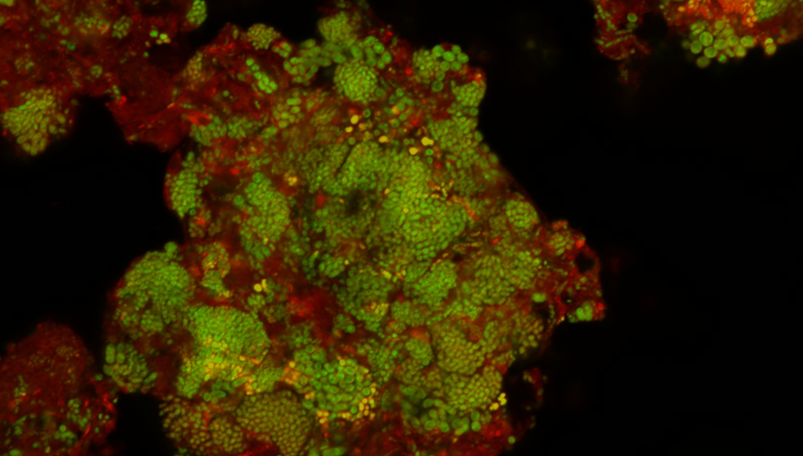Producing biopolymers from wastewater
Alan Werker
Wetsus
- Wetstus
- STOWA
- Paques Biomaterials
- SNB
- Unilever
- TU Delft
A current societal challenge is achieving higher value conversion from organic residuals to renewable platform materials and chemicals. Wasted-activated sludge is rich in microbial metabolic activity and can be a functional resource. To this end, harvested surplus biomass has been demonstrated to offer significant capacity for intracellular biopolymer accumulation.
Technology
Waste municipal activated sludge can be made to accumulate approximately its organic weight in polyhydroxyalkanoates (PHAs) when fed regionally available sources of fermented organic residues. Surplus-activated sludge from industrial biological wastewater treatment processes can accumulate significantly higher levels of PHA. PHAs are biobased and biodegradable polymers with established commercial potential as ingredients for the bioplastics, biofuel, and chemical industries.
Challenge
The principal input raw material for a PHA production bioprocess is surplus-activated sludge with significant PHA accumulation potential. A given type of polymer can be produced reliably, but industrial steps and methods that will ensure reproducibly consistent efficiency in production are not well established. Ideally, one should reach a maximal content of PHA with the highest possible molecular weight, in as much biomass as possible, within the smallest volume, in the shortest time, and with the least amount of input substrate. Conditions, and ultimately, to reach a novel strategy in bioprocess operation and control that is meaningful for practical implementations.
This project aims to build on the already existing wealth of experience within the project partner team and establish fundamental and engineering principles to ensure a consistent biomass response to PHA accumulation.
Solution
Societal water quality management infrastructures can gain a duality in function as renewable resource (biopolymer) production facilities if the biomass response and PHA production yields in PHA accumulation bioprocesses are robust and productivities are optimized. Efficient and reliable PHA production methods and processes that can be integrated into the material flows and economies for the regional realms of industrial and municipal water quality management activities would enable maximal leverage in value.
Results
Estevez Alonso, A. (2022). Polyhydroxyalkanoate production by municipal waste activated sludge: Tackling scaling-up process challenges. https://doi.org/10.4233/uuid:9a0c1794-78c8-4669-85eb-25d8318c4d78
Mulders, M., Estevez-Alonso, A., Stouten, G. R., Tamis, J., Pronk, M., & Kleerebezem, R. (2020). Volatile fatty acid product spectrum as a function of the solids retention time in an anaerobic granular sludge process. Journal of Environmental Engineering, 146(8), 04020091. https://ascelibrary.org/doi/abs/10.1061/(ASCE)EE.1943-7870.0001768
Werker, A., Pei, R., Kim, K., Moretto, G., Estevez-Alonso, A., Vermeer, C., … & de Vries, E. (2023). Thermal pre-processing before extraction of polyhydroxyalkanoates for molecular weight quality control. Polymer Degradation and Stability, 209, 110277. https://doi.org/10.1016/j.polymdegradstab.2023.110277
Estévez-Alonso, Á., Pei, R., van Loosdrecht, M. C., Kleerebezem, R., & Werker, A. (2021). Scaling-up microbial community-based polyhydroxyalkanoate production: status and challenges. Bioresource Technology, 327, 124790. https://doi.org/10.1016/j.biortech.2021.124790
Estévez-Alonso, Á., Altamira-Algarra, B., Arnau-Segarra, C., van Loosdrecht, M. C., Kleerebezem, R., & Werker, A. (2022). Process conditions affect properties and outcomes of polyhydroxyalkanoate accumulation in municipal activated sludge. Bioresource Technology, 364, 128035. https://doi.org/10.1016/j.biortech.2022.128035
Estévez-Alonso, Á., van Loosdrecht, M. C., Kleerebezem, R., & Werker, A. (2021). Simultaneous nitrification and denitrification in microbial community-based polyhydroxyalkanoate production. Bioresource Technology, 337, 125420. https://doi.org/10.1016/j.biortech.2021.125420
Estévez-Alonso, Á., Arias-Buendía, M., Pei, R., van Veelen, H. P. J., van Loosdrecht, M. C., Kleerebezem, R., & Werker, A. (2022). Calcium enhances polyhydroxyalkanoate production and promotes selective growth of the polyhydroxyalkanoate-storing biomass in municipal activated sludge. Water Research, 226, 119259. https://doi.org/10.1016/j.watres.2022.119259
Pei, R., Estévez-Alonso, Á., Ortiz-Seco, L., Van Loosdrecht, M. C., Kleerebezem, R., & Werker, A. (2022). Exploring the limits of polyhydroxyalkanoate production by municipal activated sludge. Environmental Science & Technology, 56(16), 11729-11738. https://doi.org/10.1021/acs.est.2c03043
